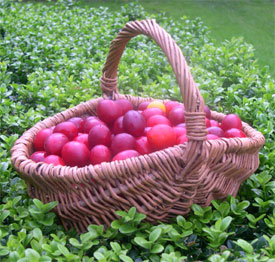It's easy to get scared by the idea of doing embroidery; needles are both fiddly and pointy, mistakes are easy to make and difficult to attend to, and it isn't often done these days so guidance from elder relatives can be sparing. However - after an obsessive cross-stitch phase in my childhood, I became determined to take up my needle again, and so I offer this pictorial evidence of what you can achieve without a pattern from a kit.
Learning to sew in itself is a bit tricky for me to show you just on a blog, but there are lots of books and old people around who could teach you the basics. For masterpieces such as above, You Will Need: Scissors, fine white cloth of any kind, coloured embroidery thread (try John Lewis), needle, small embroidery hoop (ditto), computer and printer, pencil and strong black pen.
Decide on your image. I wanted a goldfinch because birds make good stand-alone subjects and come in interesting colours. A great tit was abandoned after the embroidery hoop pulled the pattern out of shape. Print out your images in black and white or colour and trace them with the black pen onto a separate sheet. If you can't see the image through the paper do your best to sketch from example with your pencil, then go around the outlines with the pen. Cut out the pen drawing.
Place the drawing behind the cloth and fit the cloth into the embroidery hoop so that you can see the pattern through the cloth. If you can't, hold it up to a window or light to remember your way. Make sure that the hoop is aligned properly and the cloth pulled tight. Begin sewing with fine black thread, using backstitch, along all the outlines.
When you've finished the outlines of your image, you don't need the paper pattern any more. Take the work out of the embroidery hoop and carefully cut or pull away the paper from the back of the work (if it won't come easily, no worries - it won't show later). Most of the edges will have been nicely perforated by your sewing earlier. When the paper is mostly or all gone, put the work back into the hoop and fill in the blocks of colour using long and short stitch.
This way you can make any image you like, or even, if you're a better draughtsman than a sewer, design your own. For a first try choose a small, simple subject which doesn't have too much fiddly detail. There are three key things to remember about doing needlework of any kind:
1) Never use a thread longer than your own arm. When pulling from a bobbin or skein, hold the body of the thread in one hand near your chest, pull out the length you need with your other hand, and stop when your arm is fully extended. Cutting the thread with your teeth means that the end is already wetted to push easily through the needle, and you don't have to let go to get your scissors. When you have this long thread, pull about half of it through the needle so that you're only working with a short length at a time.
2) While you're sewing, occasionally let the thread lie on the surface of the work so you can see it curling up. Then twiddle the needle in the opposite direction until the thread lies flat. This reduces the chance of tangles happening when you pull through the material.
3) If you do get a tangle, don't panic! Either snip it out, which is cowardly but effective, and remember to tuck the cut ends under new stitches so that they don't unravel - OR - very slowly tug on each loop and you may find that the culprit is one small loop which simply undoes when the thread is gently pulled taut. Then dangle your needle to untwist the thread and start again.














